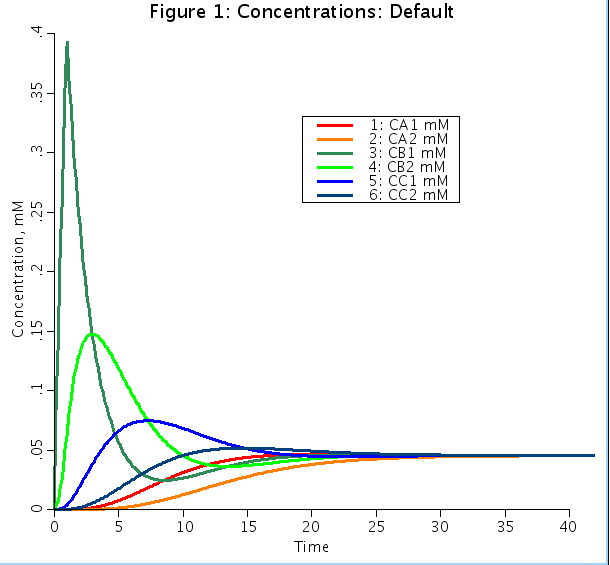Six compartment model with flow, exchange, and recirculation.
Description
System is composed of 6 compartments, five of them in series, with one
in parallel. The system is divided into three operators with recirculation
as diagrammed. Exchange is allowed in only the first operator. The second
and third operators are each composed of two stirred tanks operators in series.
The input function, Cin, is positioned between the first and second
operators but could be positioned anywhere. A fractional clearance occurs
between the output of the third operator with the remainder recirculating
to the first operator.
This model can be used to explore the theory of John L.Stephenson,
Bull Math Biophys 10: 117-121, 1948.and Bull Math Biophys 22:1-17, 1960.

Figure: A plot of concentration as a function of time for each of the compartment outflows, where CC2 is the outflow conentration from the system before recirculating into compartment CA1. Concentrations are in mM.
Diagram:
CC2*(1-clear)
<----------<---------------------------<---------------<---------------<
Fp| OPERATOR 1 Cin OPERATOR 2 OPERATOR 3 |
| _________________ | ______ _______ _______ _______ ^
v |Vp CA1(t) | CA1 v |VB1 | |VB2 | |VC1 | |VC2 | |
Creturn -->| |--->(+)--->| CB1 |->| CB2 |----->| CC1 |->| CC2 |->|
| PSg | |_____| |_____| |_____| |_____|
| ^ |
--------|-------- FLOW = Fp ml/(g*min) -->
| v |
| |
|Visfp CA2(t) |
-----------------
Equations
The equations for this model may be viewed by running the JSim model applet and clicking on the Source tab at the bottom left of JSim's Run Time graphical user interface. The equations are written in JSim's Mathematical Modeling Language (MML). See the Introduction to MML and the MML Reference Manual. Additional documentation for MML can be found by using the search option at the Physiome home page.
Operator A, a single stirred tank with permeation into a nonflowing tank.


Operator B, a pair of tanks in series with inputs from A1 and from Cin:


Operator C, same as B but no other input:


Return to Operator A:

Where Vp is the volume of the plasma space, PSg is the permeability surface area product, Visfp is the ISF volume fraction in 1 gram of tissue, clear is the fractional clearance, VB is the plasma volume fraction in 1 gram of B tissue and VC is the plasma volume fraction in 1 gram of C tissue.
- Download JSim model MML code (text):
- Download translated SBML version of model (if available):
We welcome comments and feedback for this model. Please use the button below to send comments:
John L.Stephenson, Bull Math Biophys 10: 117-121, 1948. John L.Stephenson, Bull Math Biophys 22:1-17, 1960.
Please cite https://www.imagwiki.nibib.nih.gov/physiome in any publication for which this software is used and send one reprint to the address given below:
The National Simulation Resource, Director J. B. Bassingthwaighte, Department of Bioengineering, University of Washington, Seattle WA 98195-5061.
Model development and archiving support at https://www.imagwiki.nibib.nih.gov/physiome provided by the following grants: NIH U01HL122199 Analyzing the Cardiac Power Grid, 09/15/2015 - 05/31/2020, NIH/NIBIB BE08407 Software Integration, JSim and SBW 6/1/09-5/31/13; NIH/NHLBI T15 HL88516-01 Modeling for Heart, Lung and Blood: From Cell to Organ, 4/1/07-3/31/11; NSF BES-0506477 Adaptive Multi-Scale Model Simulation, 8/15/05-7/31/08; NIH/NHLBI R01 HL073598 Core 3: 3D Imaging and Computer Modeling of the Respiratory Tract, 9/1/04-8/31/09; as well as prior support from NIH/NCRR P41 RR01243 Simulation Resource in Circulatory Mass Transport and Exchange, 12/1/1980-11/30/01 and NIH/NIBIB R01 EB001973 JSim: A Simulation Analysis Platform, 3/1/02-2/28/07.

